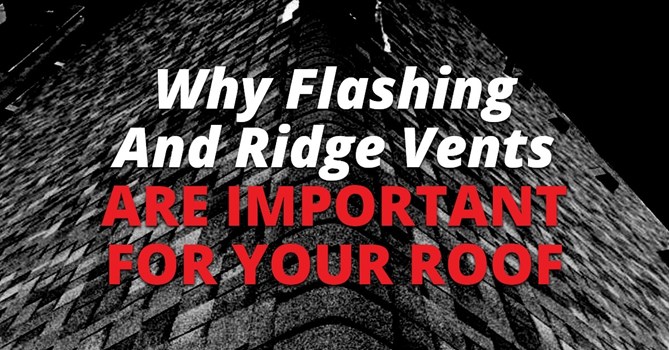Why Flashing And Ridge Vents Are Important For Your Roof

It shelters you, your whole family, your pets, all your prized possessions. It is the roof of your southeastern Massachusetts, Cape Cod or Rhode Island home, and it has you curious. Perhaps you are aware (many homeowners aren’t) your roof is an integrated system of parts. Now you have questions about some of those parts. Let’s take a closer look at two major components the safe way, with our feet on the ground (never climb onto your roof!).
Ridge Vents
No matter the steepness (pitch) of your roof, it eventually ends up somewhere scraping the sky. The top, horizontal line of your roof is the ridge, where you will find ridge vents.
In earlier days, roofs were built to be tight, leak-proof envelopes, except for the occasional small gable end vent. They promptly developed a variety of ailments:
- Mold
- Mildew
- Warped sheathing
- Thermal expansion
- Curled or keystoned shingles
- Heat-damaged insulation and sheathing
Attics typically saw their temperatures soar in summer and plunge into icy cold depths in winter. Then roofing materials makers realized ridge vents would alleviate a lot of symptoms gable vents just could not tackle. Ridge vents today are long, formed plastic pieces that provide an escape for natural convection currents of rising air inside your attic.
Roofers carefully cut a narrow slit down both sides of your roof’s ridgeline. They remove the sheathing and cover the entire open span with ridge vents. These are then capped with shingles to match the rest of your roof. The shingles are not specially made; they are cut from the three tabs of your standard shingle, laid sideways, and nailed down through the ridge vent into your sheathing.
So what, you say? With the open slit along the ridge, the air inside your attic can rise and exit the attic. Where does the air come from? There are soffit vents at your roof’s eaves the small spaces at your roof’s lower edge. With an entrance and exit, attic air is constantly moving and refreshing.
The result is perfect physics: attic air is identical to outdoor air, as it should be. Both temperature and humidity levels match the outdoors, so your attic stays correctly cool in winter and seasonably warm in summer. The air is separated from your home’s interior air by proper insulation on your attic floor. Result: no premature roof issues, minimal aging, and lower energy bills.
Ridge vents are stationary air vents that almost magically fix a host of roof and attic issues while saving you money!
Flashing
Your Southeastern Massachusetts, Cape Cod or Rhode Island home’s roof is not made of a single material. Think about all that sticks up, stands out, or nestles against the roof:
- Sanitary stacks
- Kitchen and bathroom vents
- Electrical wires
- Rotary vents
- Chimneys and stovepipes
Dissimilar materials expand and contract at different rates under heat and cold. Your roof cannot butt up against your chimney, for example, and form a watertight seal. Anywhere dissimilar materials are close to one another, flashing must bridge the gap.
Flashing is usually thought of as thin metal, and most often it is. You can see it around your chimney (step flashing) and in roof valleys (valley flashing — clever name, eh?). But you can also see it in other forms:
- Rubber boots around sanitary stacks
- Thin, flexible rubber strips around vents
- Caulking around irregular roof piercings
Anything covering seams or openings between two different materials can be considered flashing. It is essential in keeping your roof water-resistant.
First Things First
If you are getting a roof replaced, expect to see ridge vents and flashing installed as part of the process.
Ridge vents will go down very near the end of a new roof installation since shingles are applied from the lower roof edge upward. Flashing is laid down as needed throughout the installation.
Good to Go?
Our first piece of advice in this article was to avoid going onto your home’s roof. So how can you tell if your ridge vents and flashing are in good working order? Neither part moves; they make no noise when doing their jobs. You can barely see them from the ground (the safest place to observe your roof).
The solution is simple:
- Contact your local, reliable roofer for an annual roof inspection, routine roof maintenance, and roof cleaning. The expert’s eye of your neighborhood roofer can spot trouble with flashing and ridge vents very early.
Your roofer can keep your roof healthy, you happy, and your bank account plump just by performing routine roof inspections and minor repairs to every part of your roof, including ridge vents and flashing.Couto Construction is here to help you with your home in southeastern Massachusetts, Cape Cod, and Rhode Island. Connect with us today to learn more about our services or learn more about your roof!